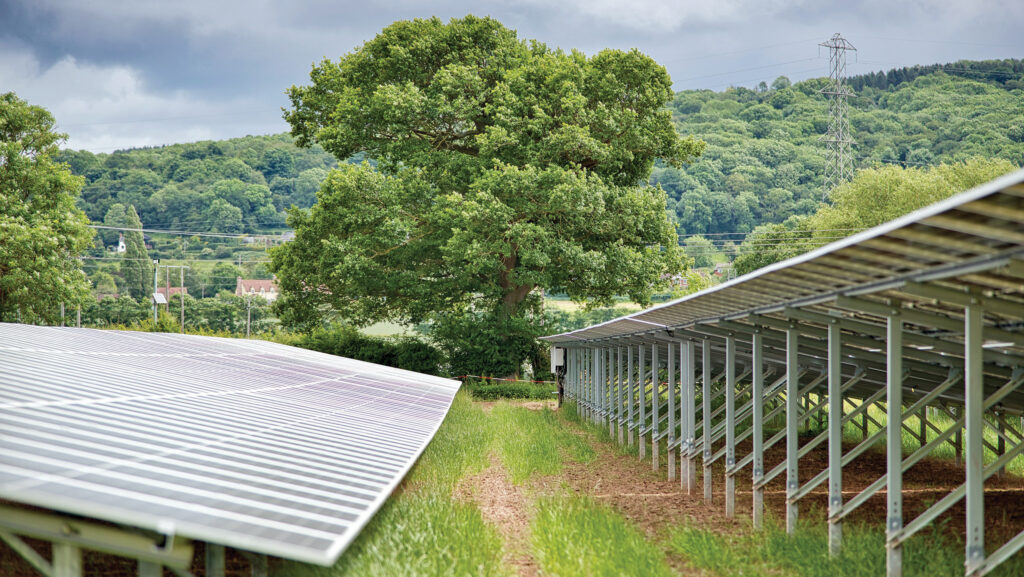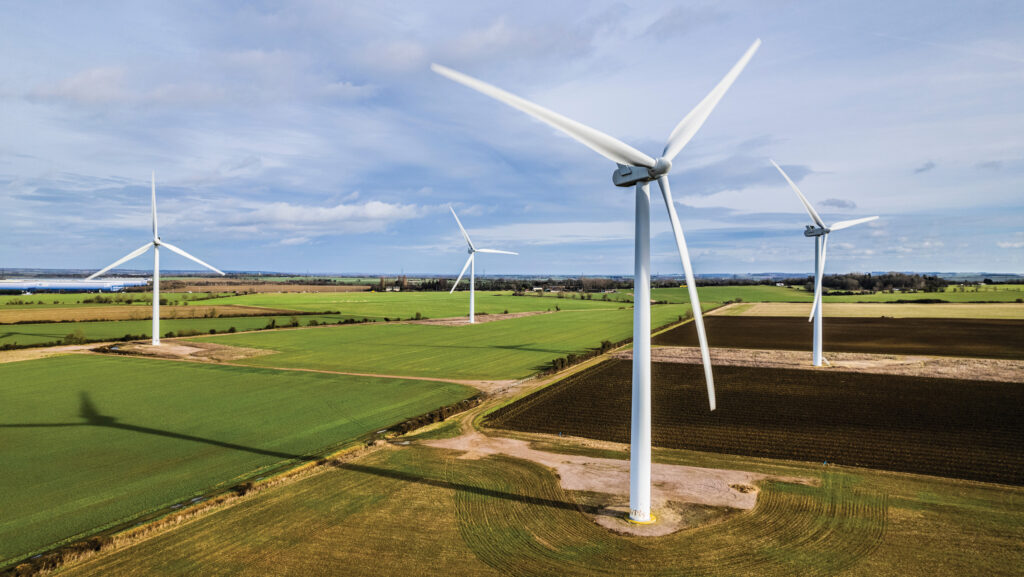Advice on legal and tax angles for renewables projects
 © Richard Stanton
© Richard Stanton Solar developers continue to look for sites and interested landowners can do much to put themselves in the best position to proceed.
Interest in potential wind turbine sites is also growing, but slowly.
Farmers Weekly looks at the processes and considerations of venturing into agreements.
See also: Solar lease opportunities: What to consider
Land rights
Clarity on who owns the land is the starting point, say advisers, so that the process does not go so far only to discover that the person proposing to sign documents doesn’t have the right to do so.
Paul Sams, managing partner at law firm Dutton Gregory, says: “Clear ownership is essential – generational land ownership often has complicated title issues, incomplete probate or informal agreements.
“It’s also not uncommon to see charges remaining on titles after the land has passed to a new owner.”
Once title is established, other related rights need to be checked – for example shooting rights, mineral rights and any right to occupy the land.
See also: Small-scale AD held back by lack of policy support as biomethane grows
If a third party has any rights then money may have to change hands to release those rights, says Naomi Stewart, head of tax at accountant Martin and Company part of the Shaw Gibbs group.
There’s no obvious type of professional advice with which to begin but it’s important that legal, tax and land agent advice is sought, she says.
“Something that might work well from a legal angle may not be so good from a tax perspective so it’s good to get all advisers together.”
Common mistake
Taking action without advice tends to be one of the most common causes of problems with projects, in terms of whether the right structure has been chosen, where the income is going and whether the plan meets the family’s aspirations, says Naomi.
There have been instances of land being allocated to a solar project without considering the knock-on effect in terms of servicing existing borrowings and the impact on overheads in the farming business, she says.
Tax aspects
The key tax advice for a renewables project is to think about the structure, says Naomi.
“Ninety-nine times out of a hundred, if you’re thinking of restructuring the land holding, it’s best to do that before planning permission is achieved and it goes up in value.
“The basic point is that someone will get an income stream and that income will be subject to direct tax whether income tax for an individual or trust, or partnership corporation tax in a company.
“These are long-term projects covering decades, so you also have to think about how things might develop over time.
“It’s possibly better to keep it out of the business and transfer the land, to keep that income outside someone’s estate before the value goes up.”
IHT relief risk
Much as the loss of 100% inheritance tax (IHT) relief is a massive blow to the agricultural sector, 50% relief is still worth a lot, so it’s important to guard against losing that, says Naomi.
“The risk with converting land which perhaps just had an agricultural purpose into a renewables purpose can jeopardise the relief not just on the land in question but on wider assets as well.”
This is because leasing out the land is regarded as investment activity rather than trading.
Too high a proportion of investment income will jeopardise the availability of business property relief (BPR) from IHT.

© Adobe Stock
“If you tip the balance from trading to investment then you’re risking all of the potential relief.”
HMRC uses an assessment known as the Balfour test, looking at the proportion of each type of activity in four areas:
- Income – is it farming income, or leasing (investment) income?
- Profit – what is the source of profit?
- Land value – taking land from agricultural trading value to a considerably higher investment value “unbalances” the balance sheet in terms of trading assets versus investment assets
- Time spent by individuals on different parts of the business – this is likely to be less of an issue than the first three factors
“If you take land that was agricultural trading and put into a leasing business in a partnership for example, you’re at risk of putting the balance of activity in that partnership into investment and then you’re not going to get BPR on any of the partnership assets.”
Cashflow and tax planning also need to take account of projects often taking several years to get under way.
To keep the trading and investment sides separate, whether a renewables project is leased or owned, the general advice is to keep it outside the main farming business, says Naomi.
“It does depend on what else is going on in terms of the dynamics of that farming business – if there is very little investment activity it may be best to keep the new venture in the original business, but very often there are already other investment income streams such as commercial units, workshops or business units and adding another investment enterprise could tip it over from a tax perspective.”
Strategic collaboration
Often a solar development involves several landowners – early collaboration between them can pay off in terms of fairly, equitably and tax efficiently sharing the income from the project.
Legal issues
Lease length
Lease length – as well as establishing who owns the land and any associated rights, those considering a renewable energy project lease need to think about the long term.
Agreements for new renewable installations are now most likely to run for 30 to 40 years so those who will inherit the land need to be aware of the plans, as the estate will have to honour the agreement.
The same applies where an option is in place, says Paul Sams of Dutton Gregory.
“Remember also that this is a temporary planning permission, with reinstatement to agricultural land once the term ends.”
That reinstatement should be funded by the owner of the installation. There are several options to make sure the funds will be available for this.
Access
Check access rights to the site – if it’s a farm track, or a bridleway, who and what has the right to use it?
Fences may have to be moved to allow lorry access – do you have the right to do this?
Payments many need to be negotiated to facilitate this. “The access needs to be unfettered, including emergency access for repairs,” says Paul.
Clean land
“You want the land clean, so sort out tenancy issues and grazing licences.”
Each case depends on its facts but in some cases it is possible to give a tenancy or licence “at will” so that at the point when the landowner needs to recover possession for the project to go ahead, it is at their will as to when the tenancy or licence ends once an initial period has passed.
Services
Solar and wind projects may affect services such as water and cabling – the owners of those services still need access, and a lot of landowners don’t know where the services run, says Paul.
“Check with energy providers or other service owners for maps of services and inform them of the development. Make sure the project is planned to avoid cable and pipe runs.”
Lenders
Where there are bank charges over project land the consent of the lender will be needed for the project because the use of the land is changing. It would be very unusual for that consent to be withheld, says Paul.
Disputes
Divorce and other disputes can derail projects – agreements have to be adhered to and costly legal action could follow if they are not.
Payments
Renewable leases often include a basic rent plus a top up based on installation output. These vary widely, so advice on what is achievable should be sought from someone knowledgeable and experienced in this area.
Solar potential
The challenges facing agriculture in recent years have made farmers more willing to consider the potential of solar on their land.
Index-linked base rents have been around £400/ha for some time.
Variations depend on site size and location, also whether there is a top-up payment based on output, which generally means a lower base rent.
Initially, an option agreement and payment will secure the land for a set period. Once construction starts, a construction rent is payable, usually a percentage of the base rent.
For leased projects, a three-year option is common, which can extend to five years if progress is slow, or up to 10 years for larger sites, says Tom Sater, head of RO Energy at RO Group.
Many solar developers prefer a site of 40ha-plus, however, the RO Group generally develops sites of 5ha 8ha, generating at least 5MW.
Tom says this is a good size – economical while not changing the landscape considerably.
“There is a growing market commercially for medium scale businesses to look at purchasing power from smaller providers,” he says.
Tom points to some practical considerations for landowners, including:
- Grid connection remains the biggest initial barrier, in terms of access, timing and cost, with planning permission next
- Developers/site operators may want access to water to clean panels – factor this in
- Solar leases may oblige the developer/operator to maintain access tracks
CCTV – residential properties caught by surveillance can be blurred out
